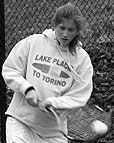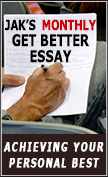DECEMBER 2008
Insights to Mastering your Game, from Jak
GETTING THE WARM-UP RIGHT
I have absolutely no idea why so many perceive the warm-up as, literally, a waste of time. Especially doubles players. I don’t get it.

Joann Cancro
Allow me to set the scene, the one that occurs every single day at clubs across America. Picture four players, approaching their assigned court shouldering tour type racket bags, dressed in proper tennis attire, and looking very professional. Unfortunately, this is where any aspirations to model themselves after professional players ends. The warm-up is about to begin.
There are a number of reasons why club players, even experienced ones, misperceive how the warm-up should proceed, resulting in well intentioned but hopelessly inefficient approaches, and, sometimes, even, unfortunately, combative.
First and foremost, club professionals should be held accountable for turning their collective backs and not even bothering to address the long established warm-up protocol. We deserve a class action malpractice suit. Second, we are seldom allowed to see the warm-up on television – which would be a great learning tool – prior to the beginning of a tour match. Commercials take precedent. Third, many players, transplants from Northern winter climates, are products of indoor contact time play where players speed through their warm-up “to get their money’s worth†for such relatively expensive court time. Fourth, there are the trite attempts at humor to end the warm-up as soon as possible. Here are my least favorite three: 1) “Let’s hurry-up and start before I’m too tired to play;†2) “Let’s hurry-up and start before I use up all my good shots;†3) “Let’s hurry-up and start since I’m not going to get any better.†With regards to the mind set revealed in number three, yes, that’s right, you are not going to get any better.
Okay, I’m just getting warmed-up for this article, so here are two more issues that undermine a productive warm-up: 1) the number of balls used, 2) poor sportsmanship. The best doubles players on planet Earth do not attempt to warm-up with 3 balls for 4 players. No wonder they’re in a hurry – who can warm-up with 3 balls? The pros have 2 to 3 cans – and ball boys and girls – to maximize the number of balls struck. Regarding respecting your opponent the game, and sportsmanship in general, the warm-up is a cooperative effort with both players hitting to each other, not away from each other so that they both have an equal opportunity at dialing in their game. It is not placement practice. That’s even in the USTA Code. C’mon!
Now, back to the actual protocol whether you’re in London, Paris, Melbourne, New York or Punta Gorda. First, ground strokes are exchanged. Then one individual takes the initiative and comes to net for some volleys. Before departing that individual asks “for some up†in order to take some overhead practice. Once they give up the net and head back to the baseline the other player follows suit for the same routine. When you think it’s time for serves first ask your partner if they are ready – they might be a bit behind you in their progression and need a few more.
Regarding serve practice: ALL PRACTICE SERVES MUST BE TAKEN PRIOR TO THE START OF THE MATCH. Once the first point of the match is played there is no more permitted practice of any kind!! Not only are you now playing by the rules but the dreaded “fbi†first-ball-in request, even in a friendly intra club, is automatically eliminated.
When you are taking your practice serves – from both sides - the receiving player should stop, or catch, those serves and then serve them back. Again, this is a cooperative warm-up, not return of serve practice. However, if you feel you have dialed in your serve, it is then alright to sacrifice your remaining serves – if others are still serving – for a few practice returns. If you do run into an opponent who immediately starts returning your serves simply state: “Aren’t you going to take any?†They cannot have it both ways and it’s up to you to explain that to them instead of being taken advantage of because you’re a nice guy.
The spin of the racket to choose serve, return, side, or defer choice to opponents (why a team would choose not to choose to defer is avoidance to me) should take place prior to the beginning of the warm-up so that you will warm-up on the side that the first game is played on. Since sun and wind can play a role in this decision it should not be taken for granted. Nothing like warming-up on the South side, then spinning the racket, and end up playing the first game at the North end where the sun in particular can be problematic at certain times of day.
If all goes wrong, and you are getting no cooperation from your opponent in the beginning of the warm-up, even after requesting it and explaining it, then tell the opponents that you’re going to warm-up with your partner instead. It’s within the rules to do that! Buy them a coke later since they’re now getting all huffy and puffy as a result of their own ignorance and boorishness.
One last item - where to stand for the first few balls in a friendly. The most functional place to position yourself for the initial groundies is smack dab in the middle of no-man’s land. This spacing between you and your opponent is now great enough to allow for a full swing, albeit relatively slow, through the ball to capture that special, optimal, world class feel for the ball on the strings. Re-inventing your timing and rhythm on a daily basis.
Beginning at the service line, worse yet in the middle of the service box actually volleying, is in complete conflict with preparing your true forehand and backhand. Specificity is what you’re seeking. Also, avoid well intentioned sprinting around right off to get the ball exclusively on one bounce. It’s the warm-up! Allowing a slightly short ball to bounce once or twice – or don’t even go for it and send the “cooperative message†- in order to create a better practice opportunity, is the smarter choice, not to mention being kinder to your still “cold†muscles and joints. One qualifier: in an inter-club team match you may be expected to warm-up beginning from the baseline – a good reason to arrive early and warm-up for the pre-match warm-up.
Okay, now, at least consider removing my name from that potential lawsuit. The ball(s) are now in your court.
Questions and comments are welcome at anytime for all tips present and past via email.
This Tip of the Month is copyright© by Jak Beardsworth Tennis. All rights reserved. Copies may be made only with the permission of and by Jak Beardsworth. Contact him here.
Tips Archive
- May, June, 2013 JUST TALKING HEADS OR MORE [read more]
- March, April, 2013 SELF-TALK: Good, Bad, or Indifferent [read more]
- January, February, 2013 BOOK-A-MILLION: Do Tennis Players Read? [read more]
- December, 2012 THE KEY TO TOUR LEVEL BALL STRIKING: And How to Learn It [read more]
- November, 2012 ARE YOU A THUDDER, A TWANGER, OR A PINGER: Racket Dampeners [read more]
- September, October, 2012 SMART SHOTS [read more]
- July, August, 2012 TEN TOP STRESS REDUCERS [read more]
- June, 2012 MAKING YOUR LESSONS STICK [read more]
- May, 2012 THE IMPOSSIBLE: Accelerating and Decelerating Simultaneously [read more]
- April, 2012 PLAYER DISCONNECTION [read more]
- March, 2012 BENDING THE SERVE IN [read more]
- February, 2012 UNDERSTANDING TERMINOLOGY: Drill vs Clinic vs Team Practice [read more]
- January, 2012 PLAYING SCARED? [read more]
- December, 2011 CUTTING OFF THE ANGLE…VERTICALLY [read more]
- November, 2011 WHY COACHING? [read more]
- October, 2011 THE EASY BALLS ARE NOT EASY [read more]
- August/September, 2011 NEVER TOO LATE FOR OLDER DOGS [read more]
- June/July, 2011 HARD COURTS, SOFT COURTS, and YOUR BODY'S ADAPTATION [read more]
- April/May, 2011 JAW DROPPNG [read more]
- March, 2011 CLUB DOUBLES' INCREASINGLY MISSING LINK [read more]
- February, 2011 TIP 2 | POOH POOHING DOUBLES STRATEGY SESSIONS [read more]
- February, 2011 TIP 1 | CLAY TO HARD, HARD TO CLAY [read more]
- January, 2011 ICING THE SERVER WHEN RECEIVING IN THE BIG MOMENTS [read more]
- December, 2010 JOHN ISNER’S “GOOD MISS” [read more]
- November, 2010 THE MOST NEGLECTED SHOT IN THE GAME [read more]
- October, 2010 BALL BOUNCING and the SERVE [read more]
- September, 2010 TAKE YOUR EYE OFF THE BALL [read more]
- July-August, 2010 SUMMER SCHOOL COURTSIDE CRIB SHEET [read more]
- May-June, 2010 THE 2-HANDED JUMP BACKHAND: The Dumbest Shot in Tennis [read more]
- April, 2010 THE STANDING AROUND SYNDROME [read more]
- March, 2010 THE ELUSIVE SERVICE TOSS [read more]
- February, 2010 PREPARING TO START THE POINT: Serving and Receiving [read more]
- January, 2010 DEBUNKING THE MODERN GAME [read more]
- December, 2009 RELAX – IT'S JUST A RALLY BALL [read more]
- November, 2009 DEFEATING THE POACHER [read more]
- October, 2009 PRACTICE, PRACTICE, PRACTICE [read more]
- September, 2009 SERVING SUCCESS: Warming-Up vs Match Play [read more]
- August, 2009 THE SPLIT STEP: Defending the Court, Rushing the Net, and More [read more]
- July, 2009 THE THIRD GROUNDSTROKE [read more]
- June, 2009 HOW MANY HANDS DOES IT TAKE? [read more]
- May, 2009 THE MOST IMPORTANT SKILL [read more]
- April, 2009 PLAYING IN THE FLORIDA WIND [read more]
- March, 2009 Letting them Play for Peak Performance in Clubland [read more]
- February, 2009 SUPPORTING YOUR GAME [read more]
- January, 2009 RESPECTING THE GAME: Top 10 Do's & Don'ts [read more]
- December, 2008 Getting the Warm-up Right [read more]
- November, 2008 Visualize...Realize: The Mind Body Connection [read more]
- October, 2008 Reading Their Mail [read more]


